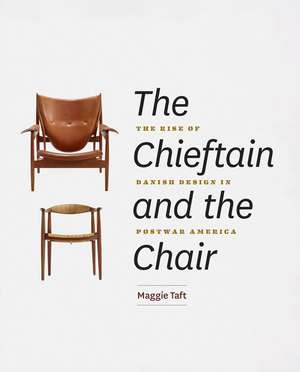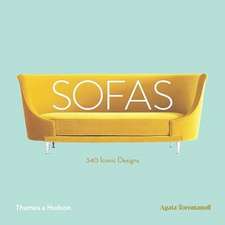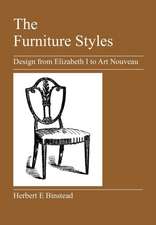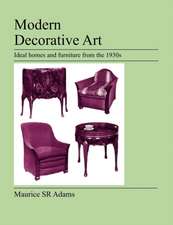The Chieftain and the Chair: The Rise of Danish Design in Postwar America
Autor Maggie Taften Limba Engleză Hardback – 22 mai 2023
Today, Danish Modern design is synonymous with clean, midcentury cool. During the 1950s and ‘60s, it flourished as the furniture choice for Americans who hoped to signal they were current and chic. But how did this happen? How did Danish Modern become the design movement of the times? In The Chieftain and the Chair, Maggie Taft tells the tale of our love affair with Danish Modern design. Structured as a biography of two iconic chairs—Finn Juhl’s Chieftain Chair and Hans Wegner’s Round Chair, both designed and first fabricated in 1949—this book follows the chairs from conception and fabrication through marketing, distribution, and use.
Drawing on research in public and private archives, Taft considers how political, economic, and cultural forces in interwar Denmark laid the foundations for the postwar furniture industry, and she tracks the deliberate maneuvering on the part of Danish creatives and manufacturers to cater to an American market. Taft also reveals how American tastemakers and industrialists were eager to harness Danish design to serve American interests and how furniture manufacturers around the world were quick to capitalize on the fad by flooding the market with copies.
Sleek and minimalist, Danish Modern has experienced a resurgence of popularity in the last few decades and remains a sought-after design. This accessible and engaging history offers a unique look at its enduring rise among tastemakers.
Preț: 131.46 lei
Nou
Puncte Express: 197
Preț estimativ în valută:
25.16€ • 26.17$ • 21.05£
25.16€ • 26.17$ • 21.05£
Carte disponibilă
Livrare economică 21 februarie-07 martie
Livrare express 06-12 februarie pentru 43.34 lei
Preluare comenzi: 021 569.72.76
Specificații
ISBN-13: 9780226550329
ISBN-10: 022655032X
Pagini: 184
Ilustrații: 16 color plates, 36 halftones
Dimensiuni: 152 x 191 x 23 mm
Greutate: 0.54 kg
Ediția:First Edition
Editura: University of Chicago Press
Colecția University of Chicago Press
ISBN-10: 022655032X
Pagini: 184
Ilustrații: 16 color plates, 36 halftones
Dimensiuni: 152 x 191 x 23 mm
Greutate: 0.54 kg
Ediția:First Edition
Editura: University of Chicago Press
Colecția University of Chicago Press
Notă biografică
Maggie Taft is an art historian and founding director of Writing Space, a community-based writing center for artists and designers in Chicago. She is coeditor of Art in Chicago: A History from the Fire to Now.
Extras
1955. Plano, Illinois. Alongside the Fox River, in a tree-lined clearing, a glass house hovers on stilts. Inside, a pair of Hans Wegner’s Round Chairs dresses the ends of a dining table set for six (fig. 0.1). The chairs’ gentle contours stand in contrast to the right angles of the building’s planes, yet their silhouettes echo the transparency of the floating glass walls. Light streams through their open teakwood frames and cane seats. An ocean away from Denmark, where they were designed and made, the chairs seem at home.
When Dr. Edith Farnsworth chose Wegner’s Round Chair—often called simply “the Chair”—for this prominent place in the country retreat Ludwig Mies van der Rohe had designed for her, refusing the tubular steel and leather pieces of his own design that he proposed, she was but one of many Americans embracing the midcentury fad for Scandinavian design. Danish design, in particular, became so popular that American manufacturers sought to capitalize on its cachet. As Danish furniture exports to the United States climbed over the course of the 1950s, American furniture companies hired Danes to design lines of modern furnishings. Some companies even referenced the craze in their names. Dansk, for example, was not a Danish company but an American one, which sometimes hired Danes to design its dinner- and cookware. Lifestyle editors featured Danish design in full-color magazine spreads, and “Danish” became shorthand for a livable, modern style associated with natural materials, quality craftsmanship, and casual comfort. (...)
Though “Danish design” appears to describe a national style, it is not interchangeable with midcentury design from Denmark. Period participants in the furniture industry understood this, even as they benefited from the publicity and growth in sales that the term and its associated aesthetic produced. “We cannot say that a Danish taste of furnishing is existing,” one prominent furniture maker told an Italian journalist in 1955, as Danish furniture exports skyrocketed.3 Americans and other foreigners, he argued, were conflating all of Denmark’s production with one small, Copenhagen-based sliver of the industry; furniture like Wegner’s Chair, though seen as representative of Danish design at large, existed alongside industrial design and folk art, neohistoricist homage and Viking-inspired kitsch. But the Italian journalist was skeptical of the furniture maker’s protest. “Danish taste must exist,” he wrote, “for the simple reason that millions of persons are convinced of its existence.”
The Danish furniture maker was not wrong in insisting that Denmark had no single, unified design identity—that its overseas exports represented neither the full range of Danish design production nor a design style embraced by all of Denmark’s nearly 4.5 million midcentury inhabitants. Nonetheless, as the Italian reporter countered, widespread belief in the idea of Danish design was enough to make it real. The version of Danish design embraced by Americans, in the postwar era and today, may have been a fiction, but its emergence as something recognizable and powerful shaped design culture and popular taste worldwide. How did this happen, and why?
The Chieftain and the Chair answers these questions by following two iconic designs—Finn Juhl’s Chieftain Chair and Hans Wegner’s Round Chair—from their conception and fabrication in Denmark to their popularization and reproduction in the United States (plates 1 and 2). The Chieftain was, as described in the New York Times, one of the “status chairs” of the 1950s. And the Chair was a media darling, appearing in a variety of contexts, including magazine features on interior design and the first televised presidential debate. The Chieftain and the Chair are both notable design achievements, as well. Though the Chieftain’s size makes it something of an outlier in a category typified by small, limber designs, its biomorphic form is emblematic of what House Beautiful called the “soft, rounded flowing forms” of Danish design. With its wooden frame suspending its upholstered seat back and armrests, it also exemplifies a structural technique often deployed by Juhl to produce a floating effect. The joinery of Wegner’s Chair is innovative, with its unbroken top rail transitioning into armrests and elegant finger joints providing structural strength that eliminates the need for a supporting backboard.
Even so, the two chairs are less exceptional than exemplary products of Danish design in the postwar period. Their stories help to show how Danish design’s popularization was the product not simply of creative genius, but of institutions, designers, fabricators, distributors, professional and amateur tastemakers, and, perhaps most surprisingly, copyists, who together brought the very idea of Danish design into existence. This diffuse activity is not unique to Danish design; understanding design history requires attending to the contexts that give shape to objects, the conditions of their manufacture, the circumstances of their circulation, and how they are taken up by the market and by consumers. Here, the Chieftain and the Chair, two familiar designs, tell the particular story of Danish Modern’s invention and rise in postwar America.
When Dr. Edith Farnsworth chose Wegner’s Round Chair—often called simply “the Chair”—for this prominent place in the country retreat Ludwig Mies van der Rohe had designed for her, refusing the tubular steel and leather pieces of his own design that he proposed, she was but one of many Americans embracing the midcentury fad for Scandinavian design. Danish design, in particular, became so popular that American manufacturers sought to capitalize on its cachet. As Danish furniture exports to the United States climbed over the course of the 1950s, American furniture companies hired Danes to design lines of modern furnishings. Some companies even referenced the craze in their names. Dansk, for example, was not a Danish company but an American one, which sometimes hired Danes to design its dinner- and cookware. Lifestyle editors featured Danish design in full-color magazine spreads, and “Danish” became shorthand for a livable, modern style associated with natural materials, quality craftsmanship, and casual comfort. (...)
Though “Danish design” appears to describe a national style, it is not interchangeable with midcentury design from Denmark. Period participants in the furniture industry understood this, even as they benefited from the publicity and growth in sales that the term and its associated aesthetic produced. “We cannot say that a Danish taste of furnishing is existing,” one prominent furniture maker told an Italian journalist in 1955, as Danish furniture exports skyrocketed.3 Americans and other foreigners, he argued, were conflating all of Denmark’s production with one small, Copenhagen-based sliver of the industry; furniture like Wegner’s Chair, though seen as representative of Danish design at large, existed alongside industrial design and folk art, neohistoricist homage and Viking-inspired kitsch. But the Italian journalist was skeptical of the furniture maker’s protest. “Danish taste must exist,” he wrote, “for the simple reason that millions of persons are convinced of its existence.”
The Danish furniture maker was not wrong in insisting that Denmark had no single, unified design identity—that its overseas exports represented neither the full range of Danish design production nor a design style embraced by all of Denmark’s nearly 4.5 million midcentury inhabitants. Nonetheless, as the Italian reporter countered, widespread belief in the idea of Danish design was enough to make it real. The version of Danish design embraced by Americans, in the postwar era and today, may have been a fiction, but its emergence as something recognizable and powerful shaped design culture and popular taste worldwide. How did this happen, and why?
The Chieftain and the Chair answers these questions by following two iconic designs—Finn Juhl’s Chieftain Chair and Hans Wegner’s Round Chair—from their conception and fabrication in Denmark to their popularization and reproduction in the United States (plates 1 and 2). The Chieftain was, as described in the New York Times, one of the “status chairs” of the 1950s. And the Chair was a media darling, appearing in a variety of contexts, including magazine features on interior design and the first televised presidential debate. The Chieftain and the Chair are both notable design achievements, as well. Though the Chieftain’s size makes it something of an outlier in a category typified by small, limber designs, its biomorphic form is emblematic of what House Beautiful called the “soft, rounded flowing forms” of Danish design. With its wooden frame suspending its upholstered seat back and armrests, it also exemplifies a structural technique often deployed by Juhl to produce a floating effect. The joinery of Wegner’s Chair is innovative, with its unbroken top rail transitioning into armrests and elegant finger joints providing structural strength that eliminates the need for a supporting backboard.
Even so, the two chairs are less exceptional than exemplary products of Danish design in the postwar period. Their stories help to show how Danish design’s popularization was the product not simply of creative genius, but of institutions, designers, fabricators, distributors, professional and amateur tastemakers, and, perhaps most surprisingly, copyists, who together brought the very idea of Danish design into existence. This diffuse activity is not unique to Danish design; understanding design history requires attending to the contexts that give shape to objects, the conditions of their manufacture, the circumstances of their circulation, and how they are taken up by the market and by consumers. Here, the Chieftain and the Chair, two familiar designs, tell the particular story of Danish Modern’s invention and rise in postwar America.
Recenzii
"Centering her study on Finn Juhl’s Chieftain Chair and Hans Wegner’s Round Chair, Taft shows how a small segment of the Danish furniture market—soon folded into a broader “Scandinavian” aesthetic, cannily developed and marketed for the booming American economy—came to rule both sides of the Atlantic."
"The Wegner chair is one of two pieces that Maggie Taft considers in her new book The Chieftain and the Chair: The Rise of Danish Design in Postwar America. The other is the Chieftain chair designed by Finn Juhl. Together, the two seem to capture two different forms of aspiration. . . .The most famous Scandi furniture now comes in flat packs, bought cheaply with a stop-off to the cafeteria for a helping of frozen meatballs with lingonberry jam. But the original appeal of Danish furniture was deeper: It promised craftsmanship at a time of ramped-up assembly line production and the pared-down aesthetic of natural wood when the space age look of new materials was ascendant. As Taft shows, these qualities were closely linked to Danish political culture in the postwar years—to its progressive thinking, vibrant democratic principles, and above all its emerging welfare state."
“Danish design (or at least stuff that looks like it) has been a fixture of American interior decoration since it was first imported in the 1950s. Pieces like Hans Wegner’s Round Chair and Finn Juhl’s Chieftain are ubiquitous, so it’s easy to forget that someone had to make people believe they were emblems of middle-class good taste before, you know, they actually were. Taft, an art historian and writer, uses this clear, tight book to trace the origins of these objects and in doing so demolishes some of the many myths about a field you know and (might) love.”
“A prolific author with contributions to national arts and design publications, Taft presents a deeply researched yet thoroughly accessible examination of the multidimensional impact of two reigning chairs and, more broadly, inspired artistic expression.”
"Succinct and engaging. . . essential for an understanding of post-war Danish and American design."
"[Taft's] story is not one of heroic artistic choices, but of compromises made for manufacturing at scale, successive counterfeits, the dispersal of a once-original style. . . . Taft tells the story with quick, fluid prose and a plethora of period texts, photographs, and scenes, taking us from the craftsmanship of the Copenhagen Museum of Industrial Art’s Cabinetmaker Day School, where Wegner trained as a joiner in the thirties, to the TV appearance of a pair of Wegner’s chairs in the Kennedy-Nixon debate in 1960."
"How did Danish Modern become a byword for mid-century cool in the United States? This study of two chairs made in 1949—The Chieftain by Finn Juhl and Round Chair by Hans Wegner—explores this tale of transcontinental tastemaking."
"We may take Danish Modern for granted. But as Taft shows in her absorbing story, the furniture aesthetic was less an expression of national spirit than a complex product of colonial relationships, protectionism, state intervention, and transatlantic salesmanship."
"This fascinating book makes a great addition to the literature of modern design and the small scale of the book makes it possible to carry."
"Taft explores the history of Danish modern design through two pieces of furniture: Hans Wegner’s Round Chair, better known as simply “the Chair,” and Finn Juhl’s Chieftain reading chair. The former is a basic dining chair, designed as part of a set, whose defining element is a single, semicircular wooden form that serves as both back and armrests—hence the “Round” in its moniker. The latter is a cushioned chair upholstered in leather, with wide armrests and a high, regal back rising above its seat. Their differences—the Chair’s slight size and the Chieftain’s heftiness; the Chair’s huge popularity in America and the Chieftain’s relative lack thereof; Juhl’s architectural education and Wegner’s training in cabinetmaking—allow Taft to develop a succinct but multilayered history of Danish Modernism."
"In this thorough exploration of two iconic Danish chairs, Taft looks to debunk old myths and makes a convincing case for a reexamination of Danish design and how it shaped the story of not only Danish modern, but also the evolution of modern design from New York to Chicago, North Dakota to Los Angeles, in post-war America."
"This book is a clever conceit—it uses two exceedingly famous chairs, Finn Juhl’s the Chieftain and Hans Wegner’s the Chair, to narrate a specific history about the creation, consumption, marketing, and reception of Danish Modern in the United States. These chairs are diplomatic actors in the drama that unfolds surrounding the small, but mighty country of Denmark making furniture for an export market in the United States, in which one could not exist without the other. The Chieftain and the Chair is a fresh and succinct contribution to Nordic design studies."
“In The Chieftain and the Chair, Taft provides a rich backstory to two fundamentally familiar mid-century furniture forms. By mining Danish-language archives and obscure American repositories, Taft makes the history of these chairs accessible to an English-speaking audience. Danish design was constructed to appeal to American consumers and American taste, as The Chieftain and the Chair deftly demonstrates.”
"Using concise and accessible language, The Chieftain and the Chair shows how the Danish furniture industry was directed to serve the American market, being also reshaped along the way."







